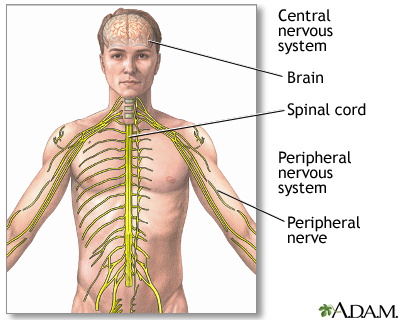Sensory nerves bring information about pain, heat, cold and other sensory phenomena to the spinal cord from various parts of the body. At least two types of nerve fibers are thought to carry the majority of pain messages to the spinal cord:
- A-delta nerve fibers, which carry electrical messages to the spinal cord at approximately 40 mph (“first” or “fast” pain).
- C-fibers, which carry electrical messages at approximately 3 mph to the spinal cord (“slow” or “continuous pain”)
A good example of how these respective nerve fibers work is the activation of the A-delta nerve fibers followed by the activation of the slower C-fibers. The activation of other types of nerve fibers can modify or block the sensation of pain.
The peripheral nervous system (PNS) is the part of the nervous system that consists of the nerves and ganglia outside of the brain and spinal cord. The main function of the PNS is to connect the central nervous system (CNS) to the limbs and organs, essentially serving as a communication relay going back and forth between the brain and the extremities. Unlike the CNS, the PNS is not protected by the bone of spine and skull, or by the blood–brain barrier, which leaves it exposed to toxins and mechanical injuries. The peripheral nervous system is divided into the somatic nervous system and the autonomic nervous system; some textbooks also include sensory systems. The cranial nerves are part of the PNS with the exception of cranial nerve II, the optic nerve, along with the retina. The second cranial nerve is not a true peripheral nerve but a tract of the diencephalon. Cranial nerve ganglia originate in the CNS. However, the remaining twelve cranial nerve axons extend beyond the brain and are therefore considered part of the PNS
After hitting one’s elbow or head, rubbing the area seems to provide some relief. This activates other sensory nerve fibers that are even “faster” than A-delta fibers, and these fibers send information about pressure and touch that reach the spinal cord and brain to override some of the pain messages carried by the A-delta and C-fibers.

The same principles apply in back pain. The nerve endings that detect pain are present in many structures in the back including the muscles and ligaments, the disks, the vertebrae, and the facet joints. When one of these parts is irritated, inflamed, or mechanically malfunctioning, the pain message will be transmitted by special peripheral nerves to the spinal cord and up to the brain. These messages can be over-ridden by other signals produced by the treatments listed previously.
The peripheral nervous system (PNS) is the part of your nervous system outside the brain and spinal cord. Its job is to connect the central nervous system (CNS)—which includes the brain and spinal cord—to the rest of the body, including your muscles, skin, and internal organs.
What the Peripheral Nervous System Does:
- Sends sensory information from the body to the brain (like touch, pain, temperature).
- Carries motor commands from the brain and spinal cord to muscles to control movement.
- Regulates involuntary functions like heartbeat, digestion, and breathing through the autonomic system.
The PNS Is Divided Into Two Main Parts:
- Somatic Nervous System – Controls voluntary actions (e.g., moving your arm).
- Autonomic Nervous System – Controls automatic functions:
- Sympathetic system – “Fight or flight”
- Parasympathetic system – “Rest and digest”
Nerve Fibers in the PNS:
Nerve fibers are extensions of nerve cells (neurons) that carry electrical signals. There are three main types:
- Sensory (afferent) fibers – Carry signals from the body to the brain (e.g., feeling heat).
- Motor (efferent) fibers – Carry commands from the brain to muscles (e.g., move your leg).
- Autonomic fibers – Control internal organs, blood vessels, and glands.
Each fiber type is part of a nerve, which is like a cable containing many fibers bundled together.
Types of Nerve Fibers by Speed and Function:
- A fibers – Large, fast-conducting. Some handle touch and muscle control.
- B fibers – Medium-sized, slower; part of the autonomic system.
- C fibers – Smallest, slowest; carry pain and temperature signals.
In short, the PNS acts as a communication highway between the brain/spinal cord and the rest of the body, using different types of nerve fibers to send and receive signals.
